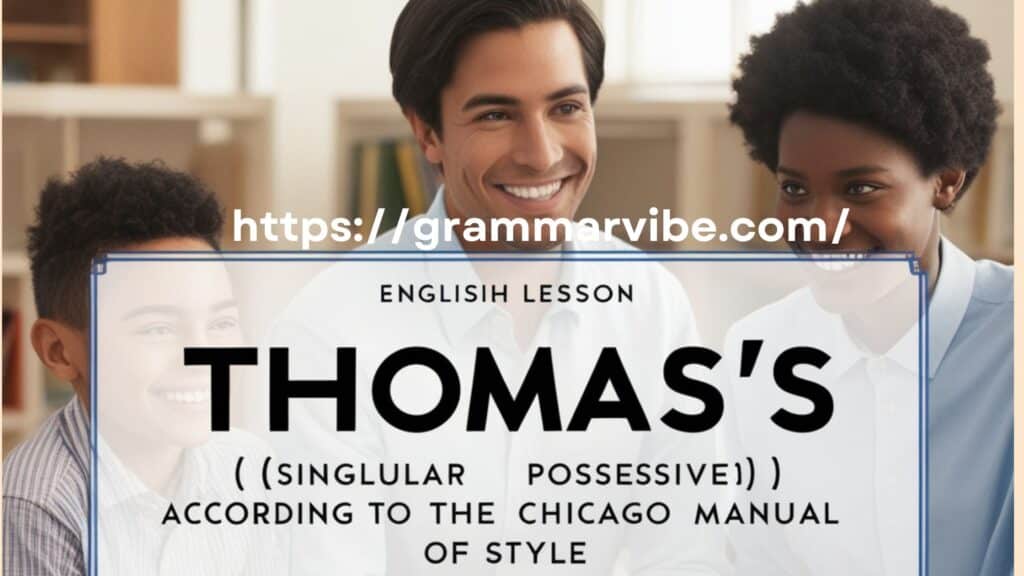One of the more complicated aspects of grammar involves understanding the correct use of possessive forms, particularly when it comes to names that already end in “s,” like Thomas. Should you write Thomas’s or Thomas’? Both are considered correct depending on the style guide you follow, but understanding when to use each can prevent confusion and ensure consistency in your writing.
In this article, we’ll dive deep into the difference between Thomas’s and Thomas’, explain which style guides prefer which form, and provide examples to illustrate the use of these possessive forms. Whether you’re following AP Style or the Chicago Manual of Style, you’ll leave this article confident in your knowledge of possessives.
What are Possessives?

Possessives show ownership or a relationship between things. They are formed differently depending on whether the noun is singular or plural. In the case of a singular possessive, we typically add an apostrophe and an “s” (’s) to the end of the noun. For example, “John’s book” shows that the book belongs to John.
But when it comes to names ending in “s,” like Thomas, the rules can differ depending on the style guide you follow.
Explore further: Months or Month’s
The Singular Possessive of Thomas
When forming the singular possessive for Thomas, there are two correct options: Thomas’s and Thomas’. Let’s take a closer look at both forms.
Thomas’s (Singular Possessive) According to the Chicago Manual of Style

The Chicago Manual of Style, which is widely used in book publishing and academic writing, prefers to add ’s to all singular nouns, even those that end in “s.” This means you would write Thomas’s to show possession.
For example:
- Thomas’s phone is on the table.
- Thomas’s job is both challenging and rewarding.
- The professor evaluated Thomas’s research project.
In these sentences, the extra “s” after the apostrophe is retained, following the guidelines of the Chicago Manual of Style.
For your interest: Today’s or Todays
Thomas’ (Singular Possessive) According to AP Style

The AP Style (Associated Press) guide, which is used by journalists and media outlets, has a different rule. It suggests that for proper nouns ending in “s,” you should just add an apostrophe without the additional “s.” This leads to the form Thomas’.
For example:
- Thomas’ family is going on vacation next week.
- I’m attending Thomas’ sister’s wedding this weekend.
- Thomas’ beach house is right by the ocean.
This simpler approach aligns with AP Style’s focus on readability and brevity. Many people prefer this form for its cleaner look, especially in contexts like news writing, where clarity is essential.
Consistency is Key
The important thing is to remain consistent within your text. If you decide to use Thomas’s, stick with it throughout the entire document. Similarly, if you choose Thomas’ for a more streamlined look, ensure that this form appears consistently in your writing. Switching between styles can confuse your readers.
Check out this: Client’s or Clients’ or Clients
Real-Life Examples: Institutions Using Thomas’s and Thomas’
An interesting way to observe the different uses of Thomas’s and Thomas’ is to look at real-world institutions.
For example:
- St Thomas’s Hospital in London follows the Chicago Manual of Style, using the extra “s” after the apostrophe.
- On the other hand, St Thomas’ University in Minnesota follows AP Style, dropping the “s” after the apostrophe.
Both are correct depending on the style guide they choose to follow, further demonstrating that there isn’t a single “right” way to handle this possessive form—it’s a matter of style and preference.
More for you: Story’s or Stories’ or Stories
Understanding Apostrophe Rules for Possessives
The apostrophe rules for possessive forms of names ending in “s” have evolved over time. In modern English, it is more common to add an apostrophe and an “s” for singular possessives. This is the rule favored by American and British English in many contexts.
However, some style guides, like AP Style, aim for simplicity, encouraging writers to use just an apostrophe for proper nouns ending in “s” to maintain clarity.
Here’s a summary of the rules:
- Thomas’s: Add ’s to singular nouns that end in “s” (Chicago Manual of Style).
- Thomas’: Add just an apostrophe to singular nouns that end in “s” (AP Style).
Other articles you’ll enjoy: Past Tense of Draw: Drew or Drawn
Examples of Thomas’s and Thomas’ in Different Scenarios

Scenario 1: Thomas’s (Chicago Manual of Style)
- Thomas’s phone was left in the conference room after the meeting.
- Thomas’s vacation plans were finalized just before the summer months started.
- The deadline for Thomas’s project is coming up soon.
In these examples, the extra “s” after the apostrophe shows ownership according to the Chicago Manual of Style.
Scenario 2: Thomas’ (AP Style)
- Thomas’ family gathered for a weekend trip at the beach.
- Thomas’ sister is planning to go abroad for her studies.
- The professor reviewed Thomas’ data analysis report with great interest.
These examples follow AP Style, where only an apostrophe is added to singular proper nouns ending in “s.”
Discover more: Other Ways to Say “Have a Nice Evening”
American vs. British English in Possessives
The debate between Thomas’s and Thomas’ extends beyond just style guides. It also touches on differences between American and British English. In both versions of English, you will often see the use of Thomas’s to indicate possession. However, as with the AP Style rule, some people opt for the simpler Thomas’, especially in casual or journalistic contexts.
Regardless of whether you use American or British English, it’s important to apply the rules consistently within your writing.
Continue exploring: Other Ways to Say “Thank You for Your Attention”
When to Use Possessives and Why They Matter
Understanding possessive forms is essential for clear and concise writing. Whether you’re talking about Thomas’s phone or Thomas’ family, knowing how to apply these grammar rules can elevate your writing and ensure that it adheres to the appropriate writing style.
Possessives in Action:
- Apostrophe rules like these help clarify ownership and avoid confusion.
- Using the correct possessive form enhances your writing’s clarity and professionalism.
- Consistent use of possessives helps readers follow your train of thought without stumbling over unnecessary errors.
Conclusion: Choosing Between Thomas’s and Thomas’
When deciding between Thomas’s and Thomas’, your choice should reflect the style guide you’re following and the tone you wish to convey. If you’re writing for a newspaper or an online publication that uses AP Style, opt for Thomas’. If you’re working on an academic or literary project that follows the Chicago Manual of Style, go with Thomas’s.
In any case, the key is consistency. Choose one form and stick to it throughout your document, ensuring that your possessive usage aligns with the proper grammar rules. By mastering these possessive forms, you’ll be able to navigate the nuances of the English language with confidence.
No matter the style, knowing the rules for possessives ensures that your writing is polished, professional, and easy to read.
Table showing all the possessive forms mentioned above:
| Form | Example | Description |
|---|---|---|
| Thomas | Thomas told me that he would be home early tonight. | Singular form of the name Thomas (no possession). |
| Thomas’s | Thomas’s phone is on the table. | Singular possessive form following Chicago Manual of Style (adds ‘s to the name). |
| Thomas’ | Thomas’ family is going on vacation next week. | Singular possessive form following AP Style (adds only an apostrophe after “s”). |
| St Thomas’s Hospital | St Thomas’s Hospital is renowned for its research. | Singular possessive form in the name of a London hospital, following Chicago Manual of Style. |
| St Thomas’ University | St Thomas’ University offers a variety of programs. | Singular possessive form in the name of a Minnesota university, following AP Style. |

Kyren Paul is an experienced blogger and the creative mind behind “Grammar Vibe.” With a passion for the nuances of English grammar, he brings clarity and insight to everyday language topics, making grammar accessible and engaging for readers of all levels.











Leave a Comment